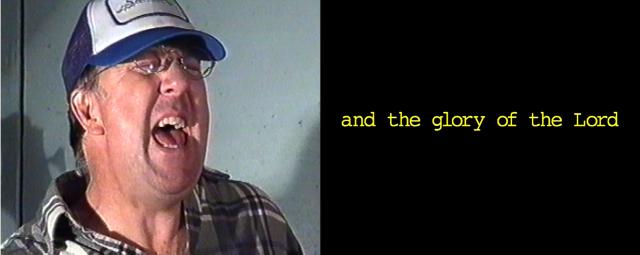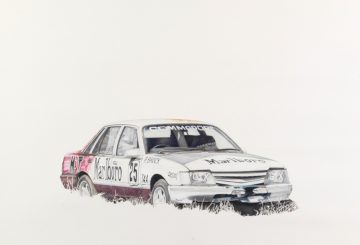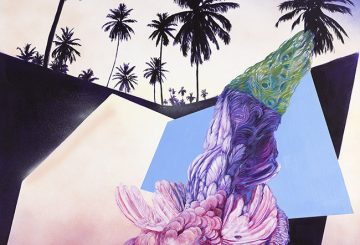Isobel Johnston talks with Richard Grayson about his recent work featured at Cockatoo Island, his directorship of the 2002 Biennale of Sydney and where sci-fi meets the Bible belt…
It’s no surprise that Richard Grayson was back in town for a Biennale entitled ‘The Beauty of Distance: Songs for a precarious Age’ it’s a title that could have been chosen as a apt descriptor for much of the work he has been doing over the last decade and particularly those works that reached completion in the last few years including his contribution to the 17th Biennale of Sydney The Messiah 2004 as well as The Golden Space City of God 2009 on concurrently at the Yuill/Crowley Gallery during May and June. Not just because they are literally songs, historically and culturally distant nor that remind us just how precariously the belief systems they represent are but also because they have the power to unsettle us.
Two-channel video installation, stereo sound, 70 mins.
Courtesy the artist; Yuill | Crowley, Sydney; and Matt’s Gallery, London
Grayson was the Director of 2002 Sydney Biennale (The World May Be) Fantastic and he has moved from one side of the proverbial art world fence to the other. He modestly infers he was an unusual choice for the role of the Director of the 2002 Biennale of Sydney. “It seems stranger now, than it did then”, he says, because with the exception of a fairly small circle and those who knew him as the Director of the Experimental Art Foundation in Adelaide he wasn’t well-known, listing himself as an artist as well as a curator and writer. This was new then but as he says, “in the context of Biennales it has all become quite fluid and various, as there are more of them they have sort novelty- you have someone like Catalan who has been drafted into putting together groups of other artists to make shows but it’s still unusual and I can’t think of any other (example)”. It might even be a first but regardless it signalled a shift within the once either or roles of artist and director. Since leaving Australia shortly after 2003, Grayson has continued to pursue all three roles yet the emphasis has been on his own art practice.
Echoing down the main freight tunnel on Cockatoo Island, one of the sites for this Sydney Biennale, are the sounds of country music from The Messiah’. Off to the side hay bales and two movies screen provide a cosy reprieve from the difficult world of art. Sitting down things are not all they seem, this shin-dig gives you the band on one screen and Charles Jennen’s text on the other. Jennen pieced together passages from the bible to provide the words for Handel’s Messiah in 1741. A couple of the songs actually take their structure from the original music slipped into the genre of Country and Western music. On closer inspection, the recording of The Midnight Amblers playing doesn’t quite work – the band’s lip sync doesn’t match and neither does the doco style recording it alludes to. It was in fact, built up over a six- month period, from sound sketches sent to Grayson in UK by the Erskineville-based band. The band comprised hip art world Sydneysiders not country hicks from the USA yet the music resonates with fever of the Bible belt.
Grayson points out that if you listen to the contract offered in the Messiah it really is quite straightforward- if you believe in this you will be returned to in the flesh to life – you move through the world differently if you believe this.
Grayson says, “there’s a temptation to see what I’m doing in terms of post-moderist ideas of equivalence – that one narrative is equivalent to another- I don’t actually believe that”. That one position occludes the other is a feature of investigation for Grayson, as he probes our various belief systems and our complacent reading of them. He shifts their music or their texts and relocates them for us. This very post-modern strategy is countered by playing it off against a very pre-modern approach where aesthetics – beauty and its message are intertwined. Like a musical score Grayson’s work has a refrains and variations, nuances and sequences that overlap and recall other earlier investigations- these quite often orbit around these same concerns- the Family of God feature in ‘The Family Starship Troopers’ – DVD-video projection 2004 and circle forward in another form in the drawings of the Golden Space City of God drawings, 2009 that was shown along with the video installation of the same name at Yuill/Crowley Gallery.
For this video installation, Grayson commissioned composer Leo Chadbourn to write an oratorio for the Family of God and Grayson compiled the libretto from pieces of their writings – as Jennen had taken his from the Holy Bible. Despite being filtered through the language of science fiction and thus heretical the hard wiring for the supernatural return is something that appears in nearly all cultures.
The oratorio was performed and recorded in San Antonio by a choir composed of believers and non-believers and a representative of the Family approved of it. Ambiguity is at the very core of Grayson’s work it is as though he puts the work out there, he maybe presenting it in a very different context yet ‘presenting stuff to make sense of it’
In more recent investigations ‘The Magpie Index’ (2010) Grayson considers “a belief system that was seemingly not based on a belief system but is …as (music icon Roy Harper) slips out of currency he becomes increasingly a prophet without honour and has sat on the margins issuing his communiqués …(and) represents a world view that has also come to an end –the idea of the ‘alternative’, the counter culture which was so important and has now sunk under the grey hegemony of consumerism and such like”.
Perhaps coincidentally; the magpie is seen as a theft of shiny things, with a harsh sound associated with various superstitious beliefs – a bearer of bad luck, trouble and unhappiness but also it is the name taken for a binary communication system which seems to nicely tie together several aspects of Grayson’s work. Orbiting arrangements of images, text and music link Grayson’s practice literally and metaphorically and so it also comes as no surprise he is now looking at the Large Hadron Collider and the ‘chatter’ generated by the multitude of voices concerned that in the search for the ‘god particle’ we might all be subsumed by the black hole it creates.



